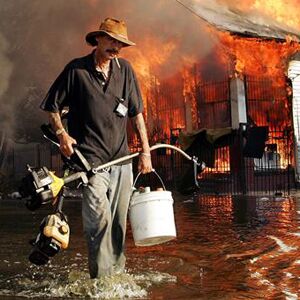
New Orleans: Social Ills One Year On
With the one-year anniversary of Hurricane Katrina approaching at the end of the month, little headway has been made in rebuilding the city of New Orleans after it was demolished in the nation’s worst natural disaster.
“In those early, early days,” writes New Orleans resident Julia Reed, “we were exhilarated. Not only had we survived, we were pioneers. It couldn’t get worse, so it had to get better, but then it didn’t. Even now, every visitor says the same thing (no tv image could prepare you for the depth and scope of the destruction), a great many neighborhoods still look like the storm happened yesterday …” (Spectator, August 19; emphasis ours).
While debris has been slow to disappear—with utility poles lying on median strips, boats still upside-down in trees; abandoned cars scattered across the city—perhaps the more telling story is the city’s social breakdown that continues to worsen.
Consider the following:
Crime: “Right after Katrina, when the murder rate hit nothing in New Orleans, there were hopes that the city’s old nemesis crime had been taken out by the storm,” Associated Press writer Alan Sayre said (August 13). Not so. Almost a year on, New Orleans’s culture of crime and lawlessness is more embedded than ever.
The murder rate has more than doubled since pre-Katrina. Ms. Reed reports that “almost all of it is drug- and gang-related, carried out by a newer, younger class of teenage hoods” (op. cit.). Associated Press says, “Suburban police chiefs and sheriffs are pulling their hair out dealing with rising crime rates” (op. cit.).
At the same time, police are receiving an increased number of calls for domestic abuse, drunkenness and brawls.
Suicide: The suicide rate has tripled, and forced commitments to mental hospitals have increased. Julia Reed reports:
A survey conducted in April by the Council on Alcohol and Drug Abuse found that one in seven people are drinking more to cope with stress; another poll by researchers at the University of New Orleans showed that symptoms of depression had doubled …. Psychiatric drug sales are holding steady at pre-Katrina levels despite the loss of population.
At the Times-Picayne, a photographer who worked through the horrendous aftermath of the storm has been institutionalised, having snapped in early August for any number of reasons—the many dead bodies he waded through and photographed, the fact that his house was destroyed and his insurance hasn’t paid up and he doesn’t know where his kids will be going to school this year. … The Volunteers of America have taken to driving a van equipped with a therapist around town in case there are people losing it on street corners.
Unemployment: Despite a largely displaced workforce and a city screaming out for rebuilding, unemployment figures are up. “[T]he jobless rate has risen above pre-Katrina levels,” Associated Press reports (op. cit.).
This is the aftermath of a disaster of biblical proportions on just one city. The uphill battle that is the rebuilding of New Orleans demonstrates America’s inability to cope with even one disaster of such magnitude.
Sadly, our peoples are not learning the lessons God intends. Further catastrophes are prophesied for the cities of America, along with those of the other nations of biblical Israel. Read “Tragedy of Biblical Proportions” to find out what God’s purpose is in such calamities—and what we can expect in the future if we don’t discern the signs of the times.
